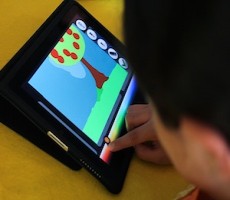The Sesame Workshop research team has been following the development of a game promoting intergenerational computer literacy. Mindy Brooks shares some of the lessons they’ve learned about designing an educational game that appeals to both parents and kids.
How do you design a game to engage both parents and children to play together and ultimately enhance the child’s literacy skills?
After hearing multiple exclamations from parents such as, “Watch out for that word!” or “No, that’s not the “t” sound!”, we (the Sesame Workshop research team) began to pick up on a very interesting pattern — parents did not understand they had an actual role in playing the game. In other words, they sat to the side and watched their children play, often making suggestions or corrections.
The game they were playing was the initial alpha version of an intergenerational computer literacy game designed for parents and children to play “together.” However, we quickly became aware that the very nature of a two player game will not guarantee that parents, in particular, will know what to do or how to play — not to mention enjoy the actual game. The question for the interdisciplinary team (producers, curriculum specialists, and research team), became how can we structure an intergenerational game play experience so that: a) parents will know they have a specific role to play in order to advance the game, b) the parent’s participation will further the learning process for their child, and c) there will be increases in scaffolding and positive interaction with fewer directives and passive observations (i.e., “Watch out for the word!”).
The primary goal of the intergenerational game was to create a literacy learning experience for a child through a game that engages a collaborative or “team” effort between a child and parent or younger child with an older child. This team effort requires that each participant contributes in a specific way (i.e., collecting target words and then unscrambling the words collected) in order to advance in the game, which subsequently enhances the learning experience for the child. In addition, the more the team works together the more points the team will receive which in turn unlock additional (and more educationally advanced) levels of game play.
Role of Formative Research Collaboration
We became acutely aware, after testing multiple times in different cities with diverse populations, that while excitement for an intergenerational game seemed high, parents and children needed more support and scaffolding to maximize the experience. Parents, in particular, had a hard time understanding that they had a strategic role in the game even though a basic instructional infrastructure was put in place. Despite a basic instructional infrastructure, it often took multiple game plays and/or researcher prompting for the parent to initiate game play (as evidenced by body position and even hand placement on the mouse). Even when parents understood that they had a role, they were still uncertain how to play the game with their child.
It was through the formative research testing process that a number of significant changes were made to the game that made it significantly stronger and more streamlined. Even though this process was specific to a couple games, we believe the implications of these changes are likely to reach to other games that are attempting to have two players work together collaboratively. We identified three major areas that should be considered for future work: role clarification, a point system, and additional support through added voiceovers, icons, and time out prompts.
First of all, when designing an intergenerational game there needs to be even further role clarification. We found that a typical instructional interface was not enough to engage parents and communicate their purpose. As a result, we tested out options about how to create more clarity regarding roles. What we found was that an interactive video tutorial adds an efficient and even fun way to provide role clarity. The tutorial introduces the player roles in a game play format by letting the pair interact with the game for a few seconds, and then follows up with further instructions. By initially establishing the roles through an interactive tutorial, it helped both players feel more comfortable and almost 100% of the participants were able to actively, not to mention enjoyably, engage in the game play experience.
We also found that another essential element to communicating roles and instructions was through the point system. Attention was brought to the points by making the on screen point tracker have corresponding sounds that reinforced (with both visual and audio cues) correct answers. In addition, the points were highlighted through the scoreboard (or a game summary screen) that clearly delineated how each player was progressing. By making the point system even more obvious during the game as well as after completing a round, it made it significantly easier for players to monitor their progress and to know that their actions significantly influenced their progress.
Moreover, by providing additional support through what seemed like minor changes, such as adding clickable support icons (like a “mouth” icon that when clicked repeated the target educational sound the team was supposed to collect), helped to repeat game goals and reinforce educational content and curricular goals. It was through these minor changes (i.e., strategically positioning icons that provide support and adding timeouts that reminded both players of their roles) on screen that brought attention and added voiceover prompts that the roles and game goals became clear to the teams.
Going Forward
When we started the process of testing the intergenerational games we heard exclamations of frustration, confusion, and lack of clarity. But at the later phases of the game development, we heard and saw a different form of interaction. It moved from a one-sided game play experience to one where parents sat down and almost immediately understood they had a purpose. Children knew to ask their parents for help and more attention was paid to the points system and how the points impacted how far they advanced. As we proceed with new innovative intergenerational game ventures, we will be keeping in mind that such an experience needs even further clarification and support than a normal game situation and that providing simple, yet intentional, instructions goes a long way in creating a game played “together.”
Mindy Brooks is the Research Analyst for Domestic Research at Sesame Workshop. She is responsible for leading field research for Sesame Workshop content including Sesame Street and Electric Company across all media platforms.




